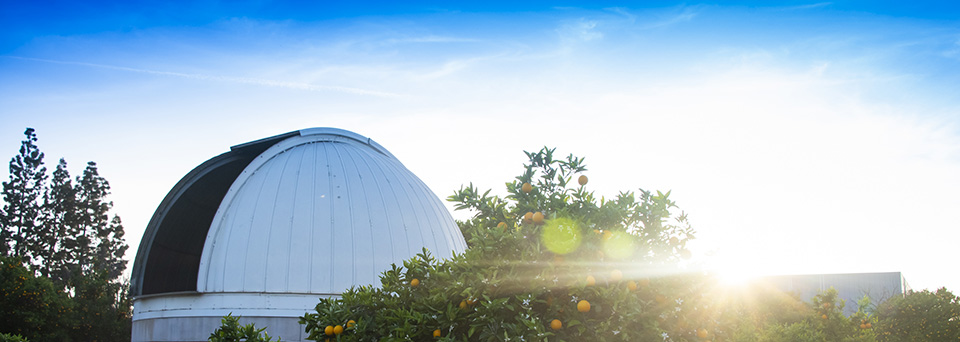Did You Know? Stars Near and Far Reveal Their Secrets to CSUN Scientists

One of CSUN’s two observatories peeks through the trees in the Orange Grove. Photo by Lee Choo.
Did you know that CSUN students can set their sights on the stars AND the sun with two on-campus observatories? If you’ve walked through the Orange Grove, you’ve likely seen the bright white half-domes of the stellar and solar observatories nestled among the trees. These two important resources offer a gateway to remarkable data and views for students, faculty and researchers.
The stellar observatory houses a 14-inch Celestron telescope that was installed in 2016. The observatory, closest to the duck pond facing Nordhoff Street, is open to CSUN physics and astronomy students in the College of Science and Mathematics for telescope training with faculty members. In the 1990s, the department hosted open houses at the facility, and faculty hope to bring back public open houses this spring.
Over the years, the telescope has been used to observe planets transiting their host star and gather information about comets and our solar system’s planets.
The solar observatory, also known as the San Fernando Observatory, was originally built by The Aerospace Corporation in the 1960s to support NASA research. It was damaged in the 1971 Sylmar earthquake and required extensive repair. In the 1970s, the company donated the facility (located on land owned by the Metropolitan Water District) to CSUN — which used the site for decades of research. In 2016, with the help of donors, the university moved the observatory to the Orange Grove when the district found other uses for the original site. Today, it sits adjacent to the stellar observatory, for student and faculty use.
Solar researcher Angela Cookson ’86 (Biology), ’90 (Applied Physics & Astronomy) collects data from the observatory on a daily basis that contributes to important ongoing research on the sun’s activity.
“Because the sun is ever-changing, it’s always cool to look at our own daily images, to watch and record how the surface of the sun changes day to day, then adding that information to the multi-year data record to eventually understand how the sun works,” said Cookson, the longtime research associate for the observatory.
The observatory is used for photometry, which “is basically a photograph of the sun in a particular wavelength,” she said. “The different wavelengths give you different information about the sun.”
The solar observatory also feeds data to outside solar and climate researchers. Studying the sun and its radiation allows them to better understand our nearest star’s effects on the Earth’s climate. Many scientists are particularly interested in the observatory’s data on an ultraviolet light known as the Calcium K line.
The observatories are not open to the public, but student tours are available upon request. Physics and astronomy majors are welcome to contact Angela Cookson or Gary Chapman, professor emeritus of physics and astronomy and solar observatory director, to receive training, ranging from opening up and aligning the telescopes to operating systems, studying data and understanding how different processes on the sun contribute to changes in the amount of energy.
The small solar observatory provides students a unique opportunity to experience hands-on aspects of astronomy, Cookson said.”To have a student look at [observatory] images for the first time and say, ‘Wow, I never knew that’ about sunspot activity, is always fun,” she said.

 experience
experience